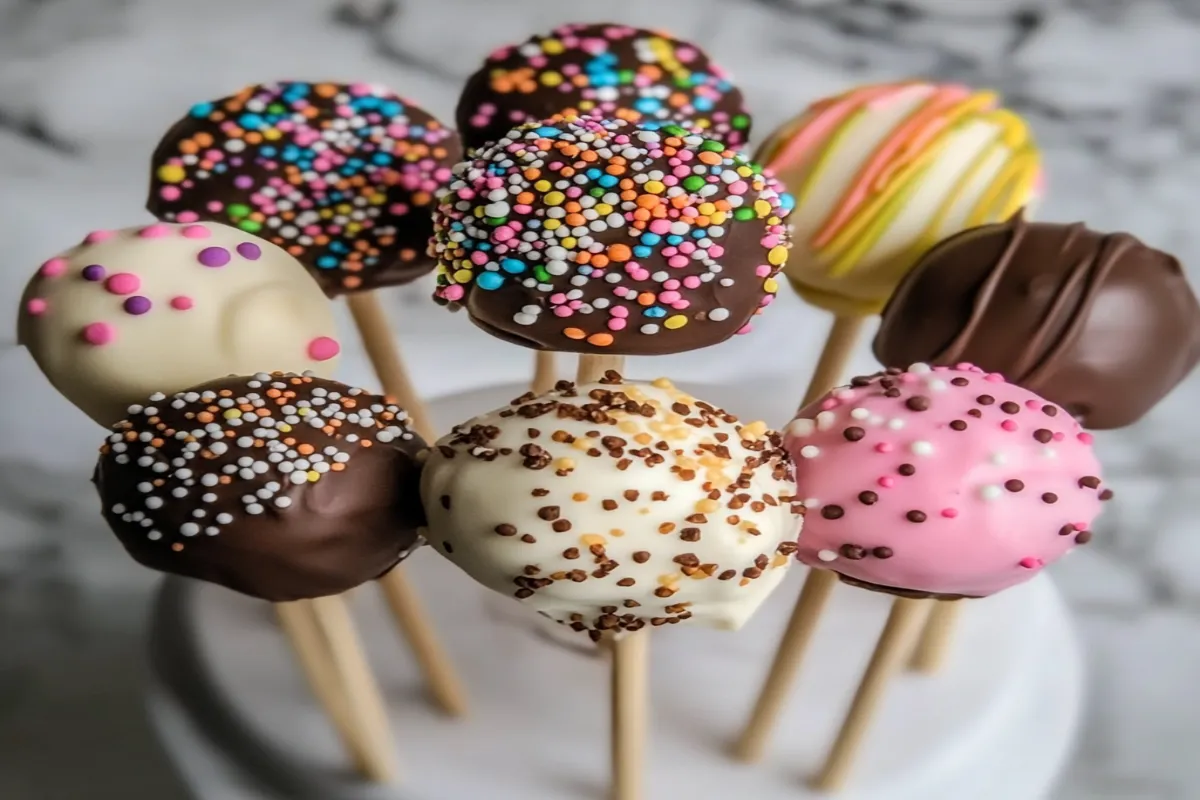Cake pops are a trendy, delightful treat that has taken the dessert world by storm. Whether served at birthdays, weddings, or even corporate events, these bite-sized morsels offer a delicious, creative way to enjoy cake in an entirely different form. But what exactly is cake pop dough made of? If you’ve ever wondered about the ingredients that go into creating these adorable treats, this article is for you. We’ll take a deep dive into the basics of cake pop dough, various ingredient options, and tips to perfect the process, and even introduce you to some popular variations.
The Basics: What is Cake Pop Dough?
At its simplest, cake pop dough is a combination of crumbled cake and frosting, mixed together to create a malleable, dough-like consistency. This mixture is shaped into small balls, placed on sticks, and coated with candy melts or chocolate. The result is a sweet, portable dessert that’s both visually appealing and delicious.
The appeal of cake pops lies not only in their taste but also in the versatility of the dough. From flavor combinations to decoration options, cake pop dough can be customized in countless ways. With a simple base of cake and frosting, you can let your creativity run wild with colors, flavors, and coatings.
But before diving into the variations, let’s start with the essentials: the core ingredients that make up the cake pop dough.
Core Ingredients of Cake Pop Dough
1. Baked Cake
The foundation of any cake pop is the cake. While you can use store-bought cake, most people opt for either a homemade or boxed cake mix. The cake can be baked in any flavor you like, but the most popular choices include:
- Vanilla cake: A classic option that pairs well with nearly any frosting or coating.
- Chocolate cake: Rich and indulgent, this is a go-to for chocolate lovers.
- Red velvet cake: With a subtle hint of cocoa and a vibrant red color, this is a visually stunning option.
- Funfetti cake: Bright and cheerful, perfect for kids’ parties.
When making cake pops, it’s important to ensure that the cake is fully cooled before crumbling. Hot cake can lead to overly moist dough, making it difficult to shape.
For some creative ideas on cake types, you might find inspiration in the Ultimate Semolina Cake Guide, where different cake bases are explored in depth.
2. Frosting
The frosting is what holds the cake crumbs together to form the dough. Without it, the cake would fall apart, making it impossible to shape. While store-bought frosting works well, many people prefer to use homemade frosting for better flavor and control over the sweetness.
Popular frosting types include:
- Vanilla buttercream: A simple and smooth option that complements almost any cake flavor.
- Cream cheese frosting: Adds a tangy depth of flavor, especially popular with red velvet cake.
- Chocolate frosting: Rich and creamy, perfect for chocolate lovers.
When mixing frosting with the cake crumbs, it’s crucial to add it slowly. You only need enough to bind the cake together; too much frosting will result in an overly wet dough that’s difficult to handle.
3. Candy Melts or Chocolate Coating
Once the cake pop dough has been formed into balls, the next step is to coat them in candy melts or chocolate. This coating not only adds sweetness but also provides a smooth, glossy finish that makes cake pops look as good as they taste.
Candy melts are available in a wide variety of colors, making it easy to match your cake pops to any theme or event. If you don’t have candy melts on hand, you can use chocolate, but it’s essential to thin it out with a bit of vegetable oil or shortening for smooth dipping.
For a detailed guide on creating smooth, beautiful coatings, you might want to check out the Cake Pop Recipe Guide, which covers everything from mixing the dough to achieving that perfect candy melt finish.
How to Make Cake Pop Dough: Step-by-Step Guide
Making cake pop dough is a fun, straightforward process. Here’s how to do it in a few simple steps:
- Bake the cake: Start by baking a cake in your favorite flavor. Allow it to cool completely before moving on to the next step.
- Trim and crumble the cake: Once the cake has cooled, trim off any dry edges. Use your hands or a food processor to break the cake into fine crumbs.
- Add frosting: Gradually add frosting to the cake crumbs and mix until the dough holds together. It should have a malleable, dough-like consistency but should not be too wet.
- Shape the dough into balls: Roll the dough into evenly-sized balls, around 1-1.5 inches in diameter.
- Insert sticks and chill: Insert cake pop sticks into the center of each ball and chill them in the fridge for about 20 minutes before dipping in candy melts.
Chilling the cake pops before dipping them ensures they hold their shape and prevents cracks in the coating. This step is especially important for avoiding common issues like falling off the stick or cracking during the coating process.
You can also read the Tricks to Making Perfect Cake Pops for more expert tips.
Variations of Cake Pop Dough

One of the best things about cake pops is their versatility. You can experiment with different flavors, coatings, and even alternative ingredients to suit dietary preferences. Here are a few fun variations to try:
1. No-Bake Oreo Cake Pops
If you don’t have time to bake a cake, Oreo cake pops are a fantastic alternative. Simply crush a package of Oreos in a food processor and mix them with cream cheese to form a dough. Roll into balls, insert sticks, and dip in candy melts for a quick, delicious treat.
2. Gluten-Free Cake Pops
For those with gluten sensitivities, you can easily make gluten-free cake pops by using a gluten-free cake mix and frosting. Many brands offer gluten-free options that taste just as good as the original versions.
3. Red Velvet Cake Pops
Red velvet cake pops are not only delicious but also visually stunning. The rich, slightly tangy red velvet flavor pairs perfectly with cream cheese frosting and a white candy melt coating. Add some red sprinkles for an extra festive touch.
4. Vegan Cake Pops
Vegan cake pops are a fantastic alternative for those following a plant-based diet. You can use a vegan cake recipe, dairy-free frosting, and vegan chocolate or candy melts to create a completely animal-product-free treat. To achieve a smooth coating, use a vegan-friendly shortening like coconut oil.
To explore more cake options, take a look at What is Semolina Cake Made Of for creative ideas on cake bases that might inspire your next cake pop recipe.
Tips for Perfect Cake Pop Dough
Making perfect cake pop dough takes some practice, but with these tips, you’ll be able to avoid common mistakes:
- Right frosting amount: Be cautious not to add too much frosting. The cake pop dough should be moist but not overly wet, making it difficult to shape.
- Chill before dipping: Once the cake balls are shaped and sticks are inserted, chill them in the fridge for at least 20 minutes. This will help the cake balls stay firm during the dipping process and prevent them from falling off the stick.
- Thin the coating: If your candy melts or chocolate are too thick, add a small amount of vegetable oil or shortening to thin it out. This will help create a smoother finish when dipping the cake pops.
- Tap off excess coating: After dipping the cake pop in the coating, gently tap your wrist to shake off any excess. This will prevent the coating from pooling at the bottom and create a clean, even surface.
Common Mistakes to Avoid
Even experienced bakers can run into challenges when making cake pops. Here are a few common mistakes and how to avoid them:
1. Too Much Frosting
Adding too much frosting to the cake crumbs can lead to a sticky, unmanageable dough. Start with a small amount and gradually add more if needed. The dough should hold together easily when rolled but shouldn’t feel overly wet.
2. Cracking Coating
Cracks in the candy coating are usually caused by temperature differences between the cake balls and the melted coating. To avoid this, make sure the cake pops are slightly chilled (but not frozen) before dipping, and ensure the candy melts aren’t too hot.
3. Cake Pops Falling Off Sticks
If the cake balls are too heavy or the sticks aren’t properly inserted, your cake pops may fall off during dipping. Be sure to insert the sticks at least halfway into the cake balls and freeze them briefly before dipping.
FAQ Section
1. What can I use instead of candy melts?
If you don’t have candy melts on hand, chocolate can be used as a substitute. To make the chocolate easier to dip, add a tablespoon of vegetable oil or shortening for every cup of chocolate. This will create a smooth, even coating.
2. Why are my cake pops cracking?
Cracking is usually caused by temperature differences between the cake pops and the coating. Make sure to dip the cake pops when they’re slightly chilled but not frozen. Additionally, let the candy melts cool slightly before dipping to avoid sudden temperature changes.
3. How far in advance can I make cake pop dough?
Cake pop dough can be made up to three days in advance and stored in the fridge. If you need to make the dough even earlier, you can freeze the undipped cake balls for up to six weeks. Just be sure to thaw them in the fridge before coating.
4. Can I make cake pops without sticks?
Yes! If you don’t have cake pop sticks, you can make cake balls instead. Simply roll the dough into balls and dip them in candy melts or chocolate, then place them on parchment paper to set.
Storing Cake Pop Dough
Proper storage is key to keeping your cake pop dough fresh. Here are some storage tips:
- Room temperature: If the cake pops have already been dipped in candy melts or chocolate, they can be stored at room temperature for up to one week.
- Refrigerator: Undipped cake pop dough can be stored in the fridge for up to three days.
- Freezer: You can freeze undipped cake balls for up to six weeks. Be sure to thaw them in the fridge before dipping to avoid cracks in the coating.
Conclusion
Cake pop dough is a simple yet versatile treat that you can easily make at home. With just a few ingredients—cake, frosting, and candy melts—you can create customized cake pops for any occasion. Whether you prefer classic vanilla cake pops or want to experiment with no-bake Oreo cake pops, the possibilities are endless.
For more inspiration and cake pop recipes, check out the Cake Pop Recipe Guide, where you’ll find everything you need to master the art of cake pop making. Happy baking!

